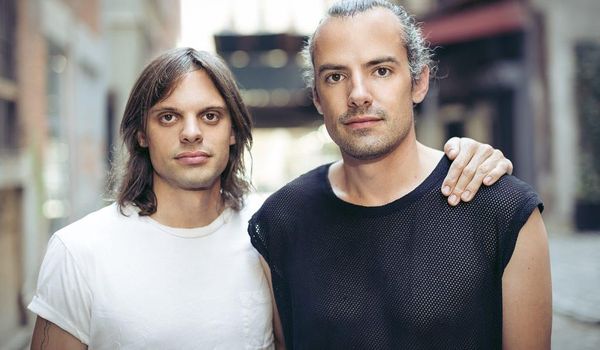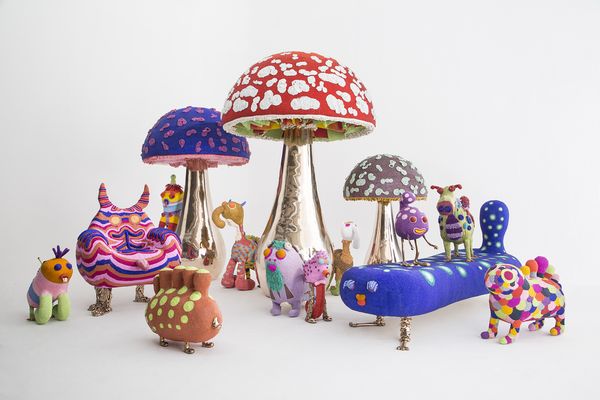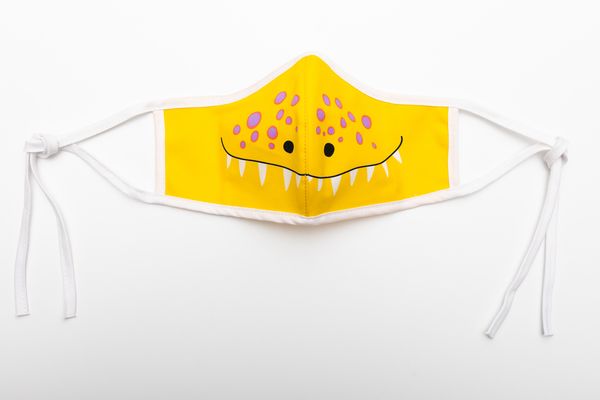Nikolai and Simon Haas
Raised in Austin, Texas, twins Nikolai and Simon Haas (b. 1984), founded The Haas Brothers in Los Angeles in 2010. Early on, the brothers received accolades for their exceptional craftsmanship. The years since have seen them evolve from fabricators and collaborators to nimble cross-pollinators in creative disciplines including fashion, film, art and design. In their current works, The Haas Brothers explore aesthetic themes related to nature, science fiction, sexuality, and psychedelia. Their mastery and uniquely clever use of materials ranging from brass, porcelain and fur, to highly technical resins and polyurethane, sets them apart as designers. In 2015, The Haas Brothers embarked on an extraordinary collaboration with women artisans in Cape Town, South Africa. The resulting series of intricately beaded sculptural objects, Afreaks, was included inBeauty, at the Cooper Hewitt, Smithsonian Design Museum, NY and at the San Jose Museum of Art, CA. In December 2018, The Haas Brothers solo exhibition Ferngully opened at The Bass Museum in Miami, Fl. Their work is in the permanent collections of the RISD Museum in Providence, RI, the Cooper Hewitt, Smithsonian Design Museum in New York, NY, and the Metropolitan Museum of Art in New York, NY. The Haas Brothers currently live and work in Los Angeles, CA. They are represented by Marianne Boesky Gallery.
We are proud to partner with leading contemporary artists, the Haas Brothers, to create limited-edition Phillips X: Face Masks. Uniquely designed to reflect each artist’s aesthetic and creativity, the face masks come in variety packs of three and with additional designs by Summer Wheat and Bel Fullana. 100% of net proceeds from sales of the masks will be distributed between The Bass Museum, Artadia, The Innocence Project and the NAACP. Buy your limited edition face mask and donate today.
"Afreaks", collaboration with the Haas Sisters, 2016. Photo by Joe Kramm, courtesy of R & Company.
PHILLIPS: Is there a specific space or object within your home or studio that you draw inspiration from, or return to, when thinking about new ideas for your work?
SIMON HAAS: At the studio, I have a room full of beads, string, pencils, paint, yarn, wires, glass cane and pretty much anything I could want to tinker with. Our friend, architect Chet Callahan, calls it a “mini Michael's” because it’s basically a craft store that I work in all day. I am the most inspired when I have a lot of raw materials around me. The idea of potential energy in physics applies to how I view that room, the more raw material I have around, the greater the potential for something to happen.
NIKI HAAS: I live inside a space inside my brain where I can visit my fantasies. My twin Simon, my wife Djuna and my little boy Fox share that space with me. Our best friend Johnny he’s there too. I love my home and my studio but the truth is I’m most inspired by jumping into the emotional and fantastical world I’ve been so lucky to be a part of with my loved ones.

"Caturday Night Fever" large scale sculpture, 2020. Photo by Ian Byers-Gamber.
P: When deciding which materials you use in your work, what are the most important factors you consider? Are there any materials you’d like to explore next that you haven’t tried yet?
SIMON: I go through periods of being interested in different building methods. Most recently I was curious about knots and weaving, before that it was about how spheres pack, before that it was about how caves build themselves. Usually, I will look at a material and think about its intrinsic properties and if there is something a material does naturally that I can exploit by performing some kind of repeated action. Think water dripping from a cave ceiling loaded with calcium—what can I do with a material over and over that will result in an interesting form or surface? I’m definitely the most interested in trying more with glass right now, but there’s a steep learning curve there so check back with me in 5 years!
NIKI: Simon and I work with lots of different materials. I feel like we have less want from a material in a physical experimental sense and we’re the most interested in what a material can do socially. Is there a thing that can support a charitable function? Is there something someone can make from home where they don’t have much work opportunity and we can share our market to influence their situation?
That’s really what we’re chasing. There are many materials out there and they all serve many great purposes.
Mask design by the Haas Brothers. Courtesy of BFA.
P: What challenges do you often face in your design or creative process?
SIMON: My biggest challenge is turning an experiment into something real, but that’s where Niki and I balance each other so well. He operates very much in the physical and I kind of operate in a more theoretical space. I make a lot of images of things and many materials samples, Niki brings everything to life.
NIKI: It’s so fun! My job is so fun. I just feel lucky to be doing it. Sometimes I’m dusty, tired, or just physically spent, but that feels good too. I just love my job. I just see lots of opportunities. Maybe the biggest challenge we face is doing our platform justice. We get to have a lot of people looking at what we do and I just hope to serve as an inspiration or a joy or perspective bender.
P: Having to step away from your usual day to day schedule, is there a book/film/project you’ll take this opportunity to begin (or return to)?
SIMON: I’ve been reading about the history of the English language, Proto-Indo-Europeans and early civilization. As a teen, I was a terrible history student, but I am suddenly getting very interested in it. I feel lucky to be getting excited about it because history is important and the content is pretty inexhaustible.
NIKI: Ya! We’re developing a cartoon with Quibi and it’s really fun.! Johnny Smith, Rashida Jones, Will McCormack and Stoopid Buddies Stoodios are doing it with us and it’s a blast! We also released a digital kids' book. It’s a lot of fun stuff.
"Handy Warhol & Handy Darling", Sculpture Milwaukee, 2019. Photo by Kevin Miyazaki, courtesy of Marianne Boesky Gallery.
P: Where is the future of your practice headed?
SIMON: We’re both focused on outdoor sculptures—maybe as a response to COVID because we want to be outside and it’s also a safer venue to view art in than a tightly packed gallery space. Definitely we would both be thrilled to make more public sculpture—Niki De Saint Phalle is resurfacing as an inspiration for us.
NIKI: We have lots of museum shows on our schedule but the future is uncertain I guess. We’re here to go with the flow. I feel like there’s going to be a whole new world out there and we’re trying to just bend like the reed in the wind. No doubt there will be lots of lessons to learn and I’m trying to mentally prepare myself for major upheaval, major learning and a real need to adapt to a new landscape. We were becoming fat cats in our own reality. I think I’m ready for training camp, to get back in shape and loose and flexible in my brain so I can make things that fit the new perspective that is presenting itself to us.
More from the Haas Brothers at Marianne Boesky Gallery
More from the Haas Brothers at R & Company



